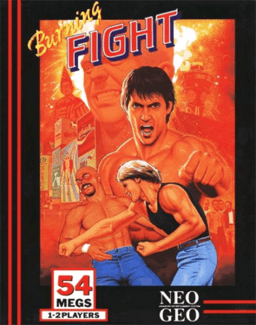Burning Fight
| Burning Fight | |
|---|---|
 Front cover of North American Burning Fight package (Neo-Geo version) | |
| Developer(s) | SNK |
| Publisher(s) | SNK |
| Designer(s) | Eikichi Kawasaki (producer) |
| Platform(s) | Arcade, Neo Geo, Neo Geo CD, Virtual Console |
| Release date(s) | August 9, 1991 (Arcade, NG) September 9, 1994 (NGCD)[1] June 23, 2008 (Virtual Console) |
| Genre(s) | Beat'em up |
| Mode(s) | Up to 2 players simultaneously |
| Arcade system | SNK Neo-Geo MVS hardware |
| CPU | 68000 (@ 12 MHz) Z80(@ 4 MHz) |
| Display | Raster, 320 x 224 pixels (Horizontal), 4096 colors |
Burning Fight (バーニングファイト) is an arcade game created by SNK in 1991 for the Neo Geo MVS system. This game is a beat 'em up, very similar to Crime Fighters. Three years after its release in arcades and on the Neo Geo AES, it was released in the Neo Geo CD as the only other home version of this game.
The producer of this game is Eikichi Kawasaki, one of the SNK founders and the man behind various famous SNK games, like Fatal Fury and Samurai Shodown series. It also was included in SNK Arcade Classics Vol. 1, released for the Wii, PlayStation 2 and PlayStation Portable in North America on May 1, 2008.
Gameplay
There are three playable characters in the game, each with their own levels of strength, agility and special moves: Ryu is quick but weak, Billy is slow but very strong, and Duke is a balanced attacker. This game uses elements that are very similar to Konami's Crime Fighters: balanced character selection, objects and weapons found on the ground cause greater damage to opponents, and semi-interactive environments (players can damage objects like phone booths and street signs along the way.) To its credit, there is one element in the game that is slightly different from crime fighters The game contains some mini-stages, where the player must defeat some enemies in a short period of time in order to win prizes. The setting is a fictional version of Osaka city (during a train station scene the platform shows a "Umida" station sign).
Most of the enemies are Japanese yakuza, but there are a few Caucasian bosses and mid-bosses (including two wrestlers that look like Hulk Hogan and Randy Savage), and the end boss is a Spanish or Italian man named Castella (Casterora in Japanese), '. Also, this game has no individual endings, no matter which character has been chosen. After defeating Castella, you are only shown various scenes of the game along with the credits, and finally a group picture of the main characters.[2]
See also
- List of Neo Geo games
- Neo Geo Battle Coliseum
References
- ↑ http://www.mobygames.com/game/burning-fight/Burning Fight info in MobyGames
- ↑ http://www.vgmuseum.com/end/neogeo/b/burnf.htm Burning Fight ending in Video Game Museum
External links
- Burning Fight at the Killer List of Videogames
- Burning Fight at MobyGames
- Burning Fight in MAWS
- Burning Fight review in Neo-Geo.com
- Burning Fight review in NeoGeoForLife.com
- Burning Fight in Rotten Tomatoes